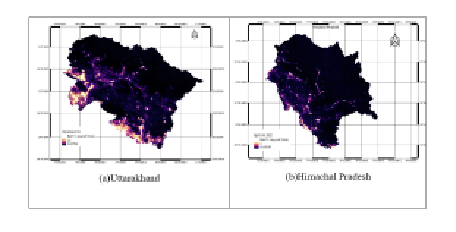


Indian Journal of Science and Technology
Year: 2022, Volume: 15, Issue: 28, Pages: 1372-1380
Original Article
Govind Verma1*, A Mehta2, S S Bhandari3
1Research scholar, Department of Computer Science, Kumaun University, India
2Associate Professor, Department of Computer Science, Convener and Head, Kumaun
University, India
3Assistant Professor, Department of Mechanical Engg, GB Pant University, India
*Corresponding Author
Email: [email protected]
Received Date:04 April 2022, Accepted Date:14 June 2022, Published Date:21 July 2022
Objectives: Application of trend detection and fuzzy time series models to predict the growth of Uttarakhand state using night-Time Lights (NTL) dataset (Visible Infrared Imaging Radiometer Suite (VIIRS) night-time lights). Methods: In this work, we propose a methodology to analyze trends and estimate different fuzzy time series models for prediction in the context of forecasting the economic growth of a low-earning income Uttarakhand state. Mann- Kendall tests are used for performing trend analysis of Uttarakhand (India) using night-time luminosity data sets. Forecasting methods based on fuzzy time series models have been presented to deal with uncertainties induced by ambiguities, vagueness, and some other non-probabilistic factors, and have widely been employed in many problems domains. The simulation is done on the Jupyter Notebook platform using night-time luminosity datasets. Findings: We conclude that Uttarakhand and Himachal Pradesh show positive growth in trends for their night-time lights monthly average intensity with magnitude of 0.002182 and 0.002558 respectively. Night time luminosity database can be used as a proxy indicator for the economic growth of the Uttarakhand state as the correlation between NTL time series data of Uttarakhand and its Gross Development Product (GDP) is 0.795641021. Fuzzy time series models can also be used to predict the growth of the Uttarakhand state and the High Order Fuzzy Time Series model gives the accuracy metrics of root mean square (RMSE) as 0.11. Novelty: No previous research work is performed on trend analysis and prediction of growth of a Uttarakhand state using night-time luminosity data sets.
Keywords: Fuzzy Systems; Fuzzy Time Series; Prediction; Night time luminosity; Satellite image
© 2022 Verma et al. This is an open-access article distributed under the terms of the Creative Commons Attribution License, which permits unrestricted use, distribution, and reproduction in any medium, provided the original author and source are credited.
Published By Indian Society for Education and Environment (iSee)
Subscribe now for latest articles and news.